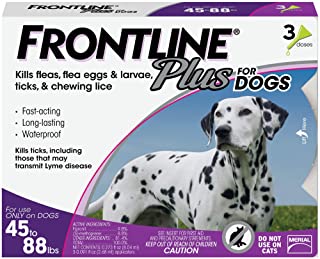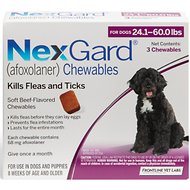![]()
HeelBoyHeel is reader supported. When you buy through any link on our site, we may earn an affiliate commission, but never at any extra cost to you.
Fleas are horrible little things.
These tiny, blood-sucking creatures really irritate your dog – they feed on blood so the biting can be sore, and their saliva can also cause an allergic reaction and itself cause itchiness in your dog.
And since the average female flea can lay 40 to 50 eggs daily, if you suspect that your dog has fleas, you need to do something about it pretty quick.
So if you’re wondering how to get rid of dog fleas, the following tips will help you do just that.

Does Your Dog Have Fleas?
First off, how do you know if your dog has fleas?
Spotting fleas on your dog is really not that difficult. Although they are very small – from 1/16 to 1/8 inch, or 1-3mm long – fleas can be seen with the naked eye if you look in the right place.
They hate light, so usually stay in the more hairy parts of your dog, like your dog’s belly and inner thighs. So just part your dog’s fur so you can see the skin underneath. If your dog has fleas, you will see them scurrying around – they are reddy brown colored, and very thin.
Another way to tell if your dog has fleas is to look not for the fleas themselves, but what they leave behind – “flea dirt” or feces.
You can either look for these on your dog’s coat – they look like specks of pepper. Or another method is to stand your dog on a wet paper towel and brush him. If little specks of dirt fall onto the towel and turn then start to spread out like a bloodstain within a few minutes, then this is flea feces – and your dog definitely has fleas.
The guys over at Banfield Veterinary Hospital have made this really helpful video to help identify if your dog has fleas.

What do you do if your dog has fleas?
Before we look at medical treatments for dog fleas, let’s take a look at some home based solutions.
- Flea Comb
A flea comb has multiple benefits. As well as helping to get rid of fleas, their larvae, and any eggs, it will also make your dog feel happy as you shower them with attention by brushing their coat. Of course, before you begin using the comb you should remember to first check the pet’s fur for any tangled hair. Comb with gentle strokes, working your way from the neck area all the way to the tail. Do not forget the paws.
You can get a very cheap flea comb on Amazon
- Flea Shampoo
If your dog loves being bathed, flea shampoo can be an excellent way to get rid of fleas. Try to find a shampoo that contains oatmeal, as this will also help to soothe their skin. The vast majority of fleas shampoos can be applied in much the same way as regular dog shampoo, but you should review the instructions on the bottle you have picked out just to be sure.
- Apple Cider Vinegar
What better way to deal with fleas than by fortifying your pet from the inside? Simply add a dash of apple cider vinegar to a bowl of water and let the dog sip from it throughout the day. The vinegar will not only act as an insect repellent since the fleas can’t stand the strong acidic odor, but the fortifying liquid will also enhance the coat of your pet.
An alternative is to mix vinegar with water – anything from a 1:1 water/vinegar solution to 3:1 if you find the smell too strong – and spray it directly onto your dog’s coat. Make sure you avoid his eyes and any open sores – vinegar stings! – and apply this once per day for a few days. Fleas hate the small of vinegar, so this can be an effective way to get rid of your dog’s fleas.
Medicinal treatments for dog fleas
If your home-based solutions to your dog’s flea issues are not working, you may need to use medicinal treatments. There are many medicinal treatments available to get rid of fleas on your dog, and if applied properly they are very effective.
There are 2 main types of medicinal treatment for fleas – topical and oral.
Topical treatment for fleas on dogs (also called “spot on” medications) is the most popular kind of treatment. This is simply poured onto your dog’s coat and is best applied between his shoulder blades so he can’t lick it off.
The big advantage of this is ease of use and application – it is very easy to use, causes no discomfort or distress, and is very effective if applied correctly.
Oral treatments for fleas on dogs come as pills or chewables. These are ingested by your dog, rather than being applied externally. Sometimes it can be difficult to get your dog to swallow pills – even when you disguise the pills with very tasty dog food, some dogs are especially good at separating out the pill!
But if your dog is particularly picky, opting for chewables will usually solve this problem.
Effectiveness of Medicinal Flea Treatments For Dogs
Some people reported that topical treatments were not as effective, but this is often because of the way they have been administered. It is very important to use apply the pour on in the correct dosage, and in the correct location (where your dog cannot lick it off).
You also need to remember that by the time you realise that your dog has fleas, they will probably have already produced 2 to 3 generations of offspring.
This means that there will be a lot of fleas at different stages – egg, larva, pupae and adult – both on your dog and in your house. It can take as long as several months for that to run its course, and you need to keep treatment going until it does and all fleas at all stages of their life cycle are wiped out.
A study published in Veterinary Parasitology found that topicals were 88.4 percent effective, while oral treatments were 99.9 percent effective. There were 128 dogs from five states involved in the study.
You can see a full range of topical treatments for dog fleas here
You can see a full range of oral treatments for dog fleas here
Conclusion
Getting rid of your dog’s fleas can certainly be a little tricky, but it is not impossible.
Natural remedies for treating dog fleas can work, but if your dog has a bad infestation of fleas, then a medicinal treatment is probably needed for quick results – both to stop your dog’s suffering, and to stop the fleas from quickly spreading to everyone else in your house!

